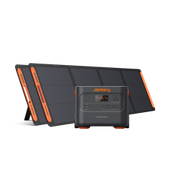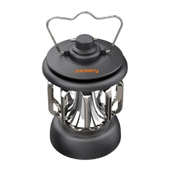How Many Watts Does A Vacuum Use?
We all use vacuum cleaners to clean our living spaces as they are easy to use, save time, and provide health benefits. However, have you considered your vacuum cleaner's hidden energy consumption or how many watts does a vacuum use? Understanding its power use isn't just about numbers; it's about saving money and being green.

This article explains why vacuum wattage is important. From energy savings to environmental consequences, we'll explain the power behind those suctioning devices. Ever heard of Jackery? How these portable power stations can power your vacuum on the fly will also be discussed. Watch to understand how wattage knowledge can transform your cleaning routine and make your home more productive, cost-effective, and eco-friendly.
|
Products |
Image |
Capacity |
Rated / Peak Power |
Battery |
Size |
|
 |
3024Wh |
3000/6000W |
NMC |
Length= 18.6in Width= 14.1in Height= 14.7in |
|
|
|
2042Wh |
3000/6000W |
LFP Li-Fe PO4 |
Length= 14.7in Width= 18.6in Height= 14.1in |
|
|
 |
2160Wh |
2200/4400W |
NMC |
Length= 15.1in Width= 10.5in Height= 12.1in |
Vacuum Wattage Key Takeaways
Here are a few essential facts about vacuums and their wattage.
Power consumption for vacuum cleaners may vary from 500 to 3000 watts, influenced by the specific model and kind.
In order to effectively clean, most contemporary vacuums take around 1200 watts of electricity.
Using a vacuum can achieve an annual accumulation of 60-120 kWh, for example, an average of 1-2 hours each week.
The annual use multiplied by the local electricity tariff gives you the consumption of electricity.
Vacuum wattage is affected by a number of factors, including the kind of vacuum (cordless, upright, canister, etc.), its age, size, amount of time used, and any power taken in standby mode ("vampire power") while the vacuum is not in use.
How Many Watts Does A Vacuum Use?
The energy consumption of a vacuum depends on its size, type, and usage. Here is a general outtake on how many watts does a vacuum use.
Upright vacuums: use 500–3000 watts to provide more suction for bigger areas or carpets.
Canister vacuums: compared to uprights, these clean, diverse surfaces with 1000 to 1500 watts and are more compact.
Stick or handheld vacuums: use 100 to 200 watts owing to their smaller size and lighter cleaning chores.
Robotic Vacuums: since they clean often but weakly, robotic vacuums use 20 to 40 watts.
Power Consumption over Time:
Here is how much watts a vacuum will consume when it’s used for one to four hours every day.
- An upright vacuum with 1500 watts uses 1.5 kWh per day or 45 kWh per month when operated for an hour.
- For four hours a day, it would use 6 kWh or 180 kWh a month.
Table based on 1500-watt vacuum cleaner:
|
Vacuum Cleaner Wattage |
Length of Time |
KWh of Electricity Used |
|
1500W |
Four Hours/day |
6 kWh |
|
1500W |
1 Week |
10.5 kWh |
|
1500W |
1 Month |
45 kWh |
Here are some factors that affect how many watts does a vacuum cleaner use?
Vacuum Type: Each type of vacuum, such as upright, canister, robotic and portable vacuums, demands different power. Robotic vacuums utilize less energy than uprights.
Motor Efficiency: The vacuum's motor efficiency affects its power consumption when suctioning. More efficient motors may clean with less energy.
Cleaning Surface: Cleaning hardwood floors or less dusty surfaces uses less force than vacuuming thicker carpets or severely soiled regions.
Accessories and Settings: Motorized heads and spinning brushes use more power. High suction mode and other power levels might use more energy.
Maintenance: A vacuum with clogged filters or limited airflow may use more energy to suction. More frequent and longer vacuum usage consumes more energy over time.
Energy Star ratings and other certifications indicate decreased energy use in energy-efficient products.
How Many Watts Do Different Vacuum Cleaners Use in a Year?
How many watts does a vacuum use in a year? Based on size, model, and use, vacuum cleaner energy consumption varies greatly. A vacuum cleaner typically uses 500 to 3000 watts per hour, however this might vary. To determine annual energy use, you need the vacuum cleaner wattage and weekly usage. Then apply this formula:
Annual energy use (kWh): = Vacuum cleaner power x daily use hours x 7 x 52.
Let’s take a 1000W vacuum cleaner as an example:
Yearly energy use (kWh): 1000W x 1 hour x 7 x 52.
Yearly energy use (kWh): 364000Wh or 364kWh
Here are some of the most known vacuum cleaner brands and their energy usage.
- Dyson: Vacuum cleaners with innovative design that caters to multiple cleaning needs and power ranging from 300 to 1800W.
- Shark: Versatile vacuums that use 500 to 1400W to combine efficiency and functionality.
- Hoover: A brand with a long-standing reputation and a list of reliable vacuums to clean your living space with 600 to 2000W power.
- Miele: These vacuums give you quality, performance, and durability with 800 to 1600W of cleaning prowess.
- Bissell: Offers products with 500 to 1500W power and user-friendly design to tackle diverse cleaning situations.
|
Vacuum Brands |
Range Wattage |
Hours Per Year Run |
Yearly kWh |
|
Dyson |
(300 to 1800)W |
364 |
(109 to 655) kWh |
|
Shark |
(500 to 1400)W |
364 |
(182 to 509) kWh |
|
Hoover |
(600 to 2000)W |
364 |
(218 to 728) kWh |
|
Miele |
(800 to 1600)W |
364 |
(291 to 582) kWh |
|
Bissell |
(500 to 1500)W |
364 |
(182 to 546) kWh |
How Much Does It Cost to Run a Vacuum Cleaner?
If you want to know how many watts does a vacuum use, chances are you want to know the cost of powering your vacuum with grid electricity. Vacuum cleaner wattage and local power prices affect operating costs. A standard vacuum cleaner uses 500-1500 watts per hour. At the U.S. national average power rate of $0.16 per kWh, operating a vacuum for an hour would cost $0.08 to $0.24.
Let's estimate monthly vacuuming at one hour every week. Assuming the mid-range of 1000 watts, multiplying by 4 (hours per month) and the power rate ($0.16/kWh), the monthly cost would be $6.40, about $76.80 annually.
Solar generators can reduce this cost and make it more sustainable. Solar energy can run your vacuum cleaner without grid electricity. Jackery's portable power stations employ clean, renewable energy to run vacuum cleaners and other home gadgets, lowering electricity expenses and carbon impact.
Speaking about Jackery, they make dependable and effective portable power stations for various energy demands. The Jackery Explorer line provides portable, eco-friendly electricity in different sizes and capacities for indoor and outdoor usage. Jackery's range may meet your energy demands, whether you need backup power or want to minimize your grid electricity use.
Jackery Solar Generators for Vacuums
Jackery provides portable power solutions for off-grid green energy, outdoor excursions and emergency backup power. A Jackery Portable Power Station stores energy from solar panels, electrical outlets, and automobile chargers. Energy is effectively stored and managed by these power plants' sophisticated batteries. Charged batteries may power cellphones, computers, cameras, electric coolers, CPAP machines and vacuum cleaners.

All Jackery power stations include A.C., USB, and D.C. output connectors, enabling customers to connect different devices. They're easy to operate and include convenient power, output, and battery displays. They are versatile enough for camping, road excursions, and R.V. experiences. They also provide backup electricity for off-grid life during power disruptions. Jackery's Portable Power Stations are popular with indoor and outdoor customers due to their mobility, durability, and efficiency.
Jackery Solar Generator 3000 Pro for Vacuum

The Jackery Solar Generator 3000 Pro is a top-tier solar power option. Its 3024Wh lithium-ion battery ensures dependable functioning. Its ultra-fast solar charging replenishes energy storage quickly. Users may connect solar panels to power storage to increase supply for longer use. Its large battery capacity and longevity ensure power output. Although powerful, it is lightweight and portable, making it an essential companion for indoor and outdoor activities. Users like its multi-functional outputs and solar, A.C., and automobile charging options for stable, eco-friendly power.
Jackery Solar Generator 2000 Plus for Vacuum

The Jackery Solar Generator 2000 Plus offers both adaptability and ease. Its 2042Wh lithium-ion battery and ultra-fast solar charging provide steady power. Expandable capacity lets consumers install solar panels to boost energy reserves. It powers several gadgets with its large battery capacity and extended lifespan. It can meet various power demands while being lightweight and portable. Users like the generator's efficiency and dependability, as well as its solar, A.C., and automobile charging options and many output ports.
Jackery Solar Generator 2000 Pro for Vacuum

The Jackery Solar Generator 2000 Pro is an efficient solar generator. It provides enough power with a 2160Wh lithium-ion battery and efficient solar charging. Power storage is flexible with expandable solar panel capacity. The large battery capacity and long life provide uninterrupted power production. Despite its powers, it is lightweight and tiny, making it portable. Its solar, A.C., and automobile charging options and many output ports make it a reliable off-grid power solution.
|
|
Solar Generator 3000 Pro |
Solar Generator 2000 Plus |
Solar Generator 2000 Pro |
|
Capacity |
3024Wh |
2042Wh |
2160Wh |
|
Battery Cell |
Lithium-ion |
Li-Fe PO4 |
Lithium-ion |
|
Cycle Life |
2000 cycles to 70%+ capacity |
4000 cycles to 70%+ capacity |
1000 cycles to 80%+ capacity |
|
Recharging Methods |
Solar Panels, A.C. Outlet, Car Port |
Solar Panels, A.C. outlet, Car Port |
Solar Panel, A.C. Outlet, Car Port |
|
Output Ports |
AC Output(x1), AC Output(x3) , USB-C Output(x2) |
AC Output(x5), USB-A Output(x2) , USB-C Output(x2) |
AC Output(x3), USB-A Output(x2) , USB-C Output(x2) |
|
Working Hours |
1000W vacuum (2.4H) |
1000W vacuum (1.6H) |
1000W vacuum (1.7H) |
How to Reduce Vacuum Electrical Usage
If you want to find out how many watts does a vacuum use to reduce or optimize energy usage here are some tips that will help you reduce electrical usage when using a vacuum cleaner.
Energy-Efficient Vacuums: Look for vacuums with energy-efficient ratings or adjustable suction. Variable-power vacuums use less energy for lighter cleaning tasks.
Use the Right Attachments: They boost efficiency. Various surfaces need various brushes or nozzles. Using fewer passes saves time and energy.
Regular Maintenance: Schedule frequent filter cleaning and brush roll debris removal. Clogged filters and tangled brushes make the hoover work harder and use more energy. Well-maintained vacuums work better.
Smart Cleaning Patterns: Vacuum from the furthest corner to the exit. Backtracking is avoided, saving time and energy. Cleaning high-traffic areas first where dirt collects is very important. By cleaning these areas first, you may save time.
Short Bursts of Use: Use quick bursts of vacuuming instead of one continuous session. The vacuum's motor rests occasionally, saving energy and minimizing overheating.
Switch off Unused functions: When cleaning hard floors or surfaces without attachments, turn off motorized functions like the brush roll and reduce energy utilization.
Manual Cleaning: For tiny messes or spot cleaning, use a handheld hoover or sweep. These use less energy than bigger vacuums.
Get a Small Vacuum: Lightweight vacuums are best for smaller spaces and basic cleaning. For less demanding chores, they use less power than heavier, more powerful vacuums.
Use Natural Light: Vacuum during daylight. This lowers the need for artificial lights, conserving energy while cleaning. These methods save energy and keep your home clean.
Vacuum Wattage FAQs
Does vacuum use a lot of electricity?
Electric vacuums often don't use a lot of power. You may save money in the long term by purchasing an energy-efficient model or one with a lower wattage. However, if you are looking for a vacuum for your workplace, like a small shop, you might need to get one with more power than your household vacuum.
How can I make my appliances consume less electricity?
To cut down on standby power, disconnect electronics when they're not in use, utilize appliances with changeable settings, clean filters and components often, and choose energy-efficient models. Use Jackery solar generators to run appliances on solar energy.
Is 600 watts enough for vacuum cleaner?
When it comes to mild to moderate cleaning, a 600-watt vacuum will do the job. It may not have the suction force of a higher-wattage model, but it gets the job done for lighter trash and smaller areas.
What makes a vacuum inefficient?
Many things may reduce a vacuum's efficiency, including clogged filters, tangled brush rolls, inappropriate attachments, neglected maintenance, and utilizing too much suction force for minor chores. Greater energy use may result from this inefficiency.
Final Thoughts
Let’s conclude our guide on how many watts does a vacuum use? Although we use a vacuum cleaner for a few hours a month, it is still enough to add a lot to the electricity bill. That is why getting a vacuum with a small wattage and scheduled use can help you reduce electricity usage. Another way to save on electricity costs is by using solar energy to power your appliances. Jackery offers a variety of solar generators that check on everyone's requirements. With Jackery solar generators, not only can you help the environment by using green energy, but you can also save more than $100 on your monthly electricity bill.
Disclaimer:
The runtime mentioned for appliances powered by Jackery is for reference only. Actual runtime may vary under different conditions. Please refer to real-world performance for accurate results.












































































































Leave a comment